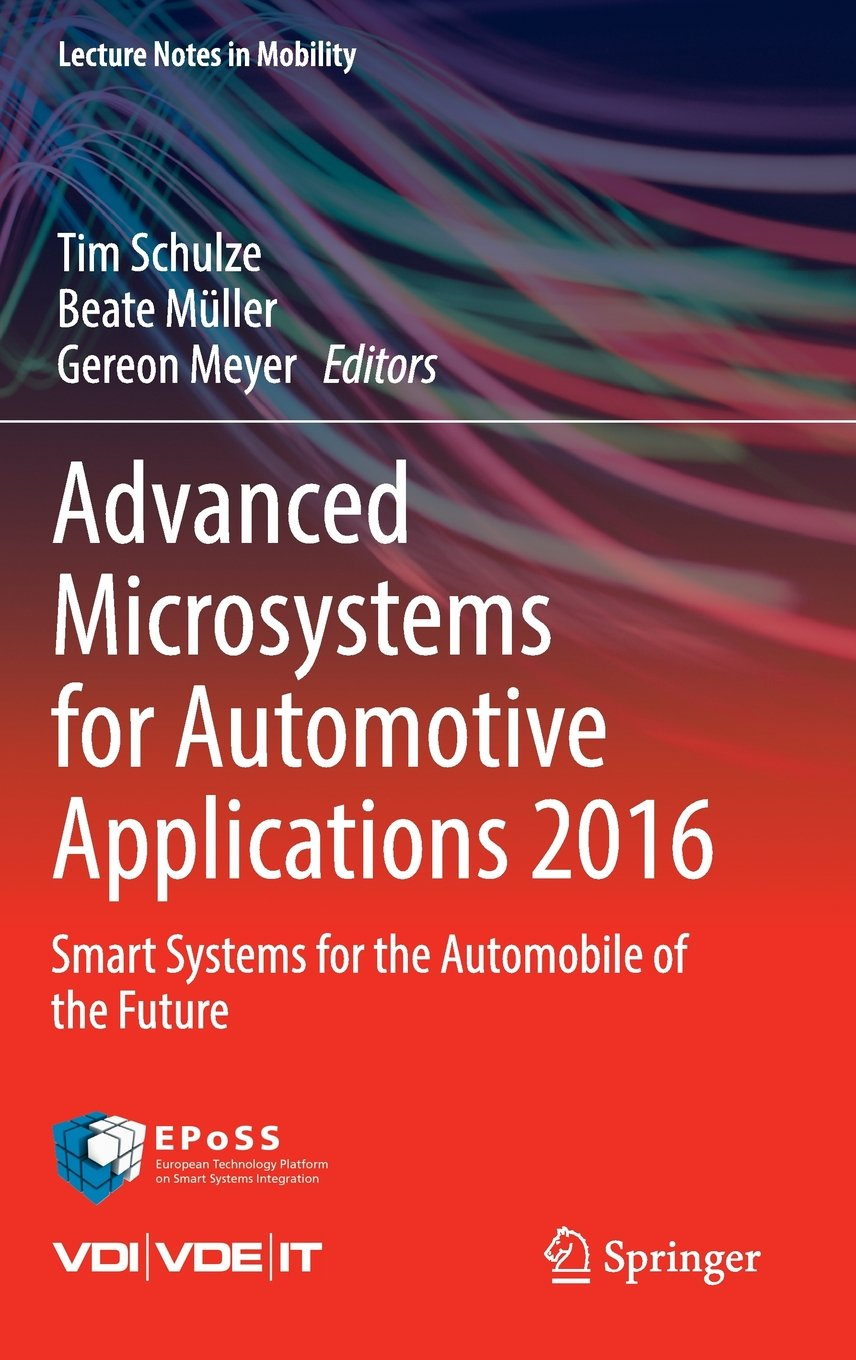Conference Book 2016
In order to guarantee a worldwide availability of all contributions to the AMAA conferences, a conference book is published in the engeneering library of Springer as part of the series "Lecture Notes in Mobility". The 2016 edition, hosting the conference proceedings of AMAA 2016, will be made available directly at the conference free of charge as part of the information material for the participants. Additional copies are available at your local bookstore or over the web.
 Advanced Microsystems for Automotive Applications 2015 - “Smart Systems for the Automobile of the Future”
Advanced Microsystems for Automotive Applications 2015 - “Smart Systems for the Automobile of the Future”
Tim Schulze, Beate Müller, Gereon Meyer (Eds.)
“Lecture Notes in Mobility”, Springer
ISBN: 978-3-319-44766-7
Automated vehicles are currently raising considerable attention of politics and industry alike. Although public funding of research and innovation on automated driving dates back as far as the 1980s, interest has been peaking very recently
following the demonstration of advanced technologies by key players that seem- ingly is at the verge of market-readiness. In effect, fierce competition is unfolding between companies regarding the enabling technologies like sensors, powerful automotive ECUs and actuators. At the same time, governments are debating on the legal and infrastructural preconditions of automated driving and about how to harmonize the necessary investments. Yet, the recent first fatal incident with a beta-state self-driving vehicle remind us that the current technology is not yet capable of mastering all complex situations.
The current developments imply two major challenges: Firstly, research and innovation efforts need to be shifted from proof-of-concept to proof-of-safety on the system level of automated driving technology. For instance, the performance envelope of sensors, data fusion and object recognition systems has been pushed considerably in recent years, but does still not cover the complexity that a vehicle encounters in everyday life. Particularly for applications in urban environments and at higher levels of automation, perception of the driving environment is a challenging task still to be mastered in a robust fashion. Smart systems integration that applies a variety of vehicle and infrastructure based sensor systems and finally links it with big data analytics in the cloud will play an important role in this domain, with safety aspects as well as validation methodology becoming a prominent future focus.
Secondly, it is obvious that the economically viable large-scale rollout of driving automation requires involvement and agreement between a large and heterogeneous group of stakeholders encompassing the automotive, IT and telecom sectors as well as road infrastructure providers and public authorities. To this end, a first initiative was launched in Sept. 2015 by Commissioner Oettinger with the Round Table Automated Driving. The recently started Coordination and Support Action “Safe and Connected Automation of Road Transport (SCOUT)” will develop a cross-sectorial roadmap regarding the implementation of high-degree automated driving in Europe, which will assist the ambition of the roundtable and may serve as a blueprint for research and innovation planning and regulatory actions in the coming years.
The International Forum on Advanced Microsystems for Automotive Applications (AMAA) has been exploring the technological foundations of con- nected, automated and electrified vehicles for many years. Consequently, the topic of this year’s 20th anniversary edition of AMAA, held in Brussels on 22–23 September 2016, is “Smart Systems for the Automobile of the Future”. The AMAA organisers, Berlin-based VDI/VDE Innovation + Technik GmbH together with the European Technology Platform on Smart Systems Integration (EPoSS), greatly acknowledge the support given for this conference, particularly from the European Union through the Coordination Actions “Safe and Connected Automation of Road Transport (SCOUT)” and “Action Plan for the Future of Mobility in Europe (Mobility4EU)”.
The papers in this book, a volume of the Lecture Notes in Mobility book series by Springer, were written by leading engineers and researchers who have attended the AMAA 2016 conference to report their recent progress in research and inno- vation. The papers were selected by the members of the AMAA Steering Committee and are made accessible worldwide. As the organisers and the chairman of the AMAA 2016, we would like to express our great appreciation to all the authors for their high-quality contributions to the conference and also to this book.
We would also like to gratefully acknowledge the tremendous support we have received from our colleagues at VDI/VDE-IT.
The automobile of the future has to respond to two major trends, the electrification of the drivetrain, and the automation of the transportation system. These trends will not only lead to greener and safer driving but re-define the concept of the car completely, particularly if they interact with each other in a synergetic way as for autonomous parking and charging, self-driving shuttles or mobile robots. Key functionalities like environment perception are enabled by electronic components and systems, sensors and actuators, communication nodes, cognitive systems and smart systems integration.
It has been the mission of the International Forum on Advanced Microsystems for Automotive Applications (AMAA) for more than fifteen years to detect novel trends and to discuss the technological implications from early on. Therefore, the topic of the AMAA 2015 will be “Smart Systems for Green and Automated Driving”, thus capturing the two mentioned mega-trends.
This book contains peer-reviewed papers written by leading engineers and researchers which all address the ongoing research and novel developments in the field. The book will be a valuable read for research experts and professionals in the automotive industry but the book may also be beneficial for graduate students.

